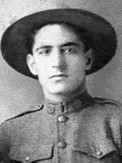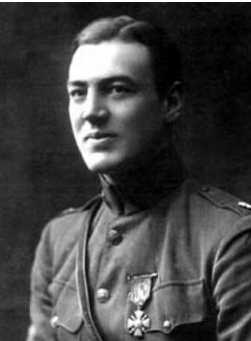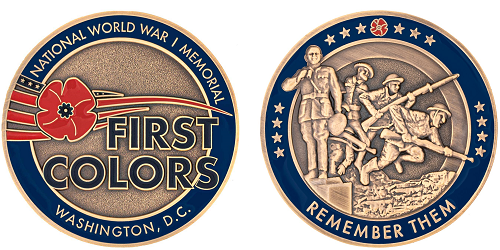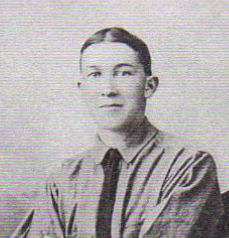|
|
|
|
March 31, 2021
 With only two weeks to go, we are counting down the days until we raise the Flag of the United States of America for the first time over the newly constructed National WWI Memorial in Washington, DC. We are honored to celebrate this momentous occasion with each of you via live broadcast on April 16. Please click on the video above to hear more from our host, Award-Winning Actor, Gary Sinise.
|
|
First Colors Ceremony will Introduce America's New World War I Memorial

A bipartisan group of U.S. Senators has introduced legislation to award the Congressional Gold Medal to the female military telephone operators who kept American and French GIs connected during World War I. The Hello Girls Congressional Gold Medal Act would award the medal to the women of the U.S. Army Signal Corps. Also known as the Hello Girls, the bilingual female switchboard operators connected more than 150.000 calls per day during the war, doing so at a rate six times faster than their male counterparts. Senate Veterans Affairs Committee Chairman Jon Tester, D-Mont., Ranking Member Jerry Moran, R-Kan., Sens. Maggie Hassan, D-N.H., and Marsha Blackburn, R-Tenn., introduced the legislation. Click here to read more about this new effort to recognize the Hello Girls with the Congressional Gold Medal.
|

Born in the Greek settlement of Alatsata, which is today located in western Turkey, George Dilboy and his family emigrated to America in 1908 when he was 12 years old. After returning to Greece to fight as a volunteer in the Greek Army in the First and Second Balkan Wars, Dilboy came back to Somervill, MA in 1914, where he went to school and worked for a few years before volunteering to fight in the U.S. Army in the Mexican Border War from 1916 – 1917, and then re-joining the U.S. Army as a private first class to fight in the trenches of France during World War I. Click here to read more, and learn about George Dilboy, who General John Pershing listed as one of the 10 greatest heroes of the war.
|

|

The United States has a Tomb of the Unknown Soldiers today because a New York National Guard Major and freshman Congressman thought it was necessary 100 years ago. Hamilton Fish III, a 32-year old lawyer with a Harvard degree who could trace his roots back to the beginnings of New York, led Company K of what became known as the 369th Infantry Regiment, which went down in history as the Harlem Hellfighters. He earned a Silver Star, and the French War Cross. Fish thought that the United States, which had suffered 116,516 deaths – 53,402 in combat and 63,114 to disease-- between April 1917 and November 1918, should have a memorial to an American Unknown Soldier. Click here to learn more about how Fish, then a Congressman, introduced the federal resolution to create an Unknown Soldier memorial on November 11, 1921.
|

A man is only missing if he is forgotten.
Our Doughboy MIA this month is Corporal William Michael Barnett, USMC ASN271629, 84th Company/3rd Battalion/6th Marine Regiment/4th Brigade/2nd Division A.E.F.
Born in Oswego, New York on June 1st, 1892, Barnett enlisted in the United States Marine Corps on August 3rd, 1917 at Syracuse, New York. He trained at Parris Island, S.C. and upon graduation from basic training was assigned to the 119th Company at Quantico on January 8th, 1918. With them he departed for France on February 25th, 1918, where he received advanced combat training in the Toulon Sector.
In late May, with the Germans threatening Paris direct, the 2nd American Division received hurried orders to shore up crumbling French lines near Château-Thierry. The 6th Marine Regiment (which along with the 5th Marines and 6th Marine Machine Gun Battalion composed the 4th Brigade of the 2nd Division) took up positions southwest of Belleau Wood and was ordered to seize the town of Bouresches, as well as clear the southern half of Belleau Wood itself. The operation began on June 6th and these attacks were the beginning of a month-long struggle that resulted in both Marine Corps glory and heavy casualties.
On June 13th, 1918, Barnett received assignment to the 84th Company, 6th Marine Regiment as a replacement for a combat casualty. By that time, he was a Corporal. After 40 days in the sector, during which time the regiment would incur 2,143 casualties, the 6th Marines were pulled off the line for rest and refitment before again being brought into the maelstrom, this time in the Battle of Soissons.
On July 16th, the regiment was rushed to the Villers-Cotterets Forest where, on the morning of July 19th, 1918 the 6th Marines attacked in force, alone, from the town of Vierzy toward Tigny but were stopped short of their objective by extremely heavy artillery and machine gun fire. It would prove to be the single costliest day the regiment would ever face with many companies seeing upwards of 50% casualties and some as high as 70%.
It was during the attack forward that morning that Corporal Barnett was killed in action by a German sniper. He was later buried in a temporary grave in a field just outside Vierzy. However, following the war Graves Registration Service personnel were never able to locate that grave.
Want to do your part? Stand up and dig in with us by visiting www.ww1cc.org/mia.
Can you spare just ten dollars? Give 'Ten For Them' to Doughboy MIA and help us make a full accounting of the 4,423 American service personnel still listed as missing in action from WW1. Make your tax deductible donation now, with our thanks.
|

Exclusive new design for 2021! Double-sided Bronze alloy medallion design commemorates the Doughboys of WWI, and the first raising of our nation's flag over the new National World War I Memorial in Washington, DC on April 16, 2021. Two-Color Soft Enamel, 1.75″ in diameter.
Our mission is to remember those who served in WWI. These commemorative gifts help make that happen.
|
|
|
|

Submitted by: Jean Burns {granddaughter}
Albert Robert Laske was born around 1894. Albert Laske served in World War 1 with the United States Army. The enlistment was in 1918 and the service was completed in 1918.
Story of Service
Feb. 1918, Albert "Bert" (24 yrs. old) received induction orders to enter the Army, during World War I. He is to serve in the 25th Spruce Squadron, Vancouver Barracks, in Vancouver Washington. This Squadron is to harvest wood that will be used to build the planes they need for the war. In Dec. 1918, Bert is discharged honorable and thanked for his service, but since the war is ending, his service is no longer needed.
About the 25th Spruce Squadron: “The states of Oregon and Washington form the backdrop for one of the most interesting dramas of the First World War. When the U.S. entered the War, it was quickly discovered that the nation had no capacity to build warplanes in quantity. Even though the U.S. had invented the airplane, by 1917 the European powers had already spent years developing it for warfare, and deploying it in deadly combat. Those nations were trying to produce enough machines to keep the skies occupied over the front lines in France.
|

|
|
|
|